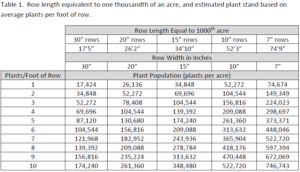Currently, less than half of our soybean acres are planted, and as growers make the switch to beans, too much rain and warm temperatures are causing a few headaches with respect to getting fields planted and maintaining a good stand. Heavy and almost constant rain this week and warm temperatures may have caused surface packing or created optimal conditions for seed and seedling rots in poorly drained spots, so it is important to get out soon and check fields that were planted within the last two weeks.
Planting: For planting in June, the best maturity group will be a maturity group 4 or 5. If irrigation is an option, maturity group 3 varieties allow for earlier harvest and have done very well in our planting date work, but have never performed as well as a fuller season bean under dryland conditions when planted late. Unless you can irrigate, put away the maturity group 3’s and work with fuller season options. TN collaborated with other states in a national planting date/maturity group study which found that maturity group 4 varieties had the best yield return as a late plant option over both maturity group 3 and even maturity group 5 varieties. Narrow rows will be critical for quick canopy closure to suppress weeds. I would plant at typical rates of 130-150K and not plant thick in order to try to force height until we get into July. Evaluate field conditions and increase seeding rates in heavy residue or with older style drills. Consider treating seed with a fungicide to help minimize seedling disease in the event June is wet. We shallowed up our planter ahead of several days of rain, but if planting ahead of dry weather, set the planter deep enough (1.25 to 1.5 inches) to get good seed coverage which will give more uniform emergence.
Replanting and Supplementing: On the question of replant, since we are heading into June, consider keeping a low but uniform soybean stand where ‘low’ is 70 to 90 thousand plants per acre (Table 1). Replant where stands are very poor or spot plant to fill in bare areas. Timely weed control will be important in fields with thinner stands that tend to canopy late. Where only spot replanting is needed, do it early while the existing crop is small. That second planting will catch up much quicker if the original stand is not more than one or maybe two trifoliates. Plant the same variety or a similar maturity bean for a more uniform crop later in the season.
In my experience, it is always best to try to keep a lower stand or replant the field than to try to supplement a thin stand. Adding to thin stands is something folks have tried over the years with varying degrees of success, and involves planting a low population of the same variety back into a field with a too-low stand. Make sure to check the seed drop rate of the equipment (some equipment cannot be set to a low enough seed drop rate which leads to overplanting and creates a real mess). Planting with the old rows to split the middles will create a skip row effect from wheel tracks. Our skip row research suggests that skipped rows don’t necessarily cause yield losses as nearby rows can compensate with their pod load, however skips leave wide open spaces for weeds. If missing rows/weed gaps are a concern, driving perpendicular or even diagonally across the old rows (think of an angled checkerboard) to increase the plants per square foot in the field can be a last resort. Plant the same variety if possible or similar maturity variety, and always use a determinate bean to supplement a thin stand of a determinate variety.

